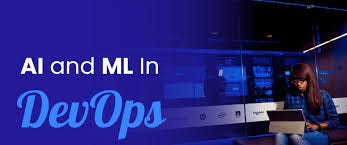How is AI/ML Supercharging DevOps in 2025?
AI/ML in DevOps
Hello there, trust you’ve been good?? Let’s talk about AL/ML in DevOps today!
From smarter pipelines to predictive operations, here’s how machine learning is reshaping modern DevOps
In 2025, DevOps isn’t just about CI/CD pipelines and YAML files anymore — it’s about intelligence. Artificial Intelligence (AI) and Machine Learning (ML) are no longer just buzzwords; they’re actively transforming how modern engineering teams build, deploy, and operate software.
Let’s break down exactly how AI/ML is powering this shift, with real-world examples, tools, and takeaways that matter for DevOps practitioners at any level.
🔧 What is AI/ML-Powered DevOps?
AI/ML-powered DevOps means using intelligent algorithms to:
Analyze pipeline data
Detect anomalies before outages occur
Automatically test and deploy only what matters
Triage incidents faster
And even fix issues before they impact users
Instead of reactive DevOps, where you wait for things to break, AI turns DevOps into a predictive, adaptive system.
💡 Real Use Cases in the Wild
1. Smarter Testing & Build Optimization
CI pipelines waste hours running irrelevant tests. AI-powered systems like Launchable or Test.ai use ML models to analyze past runs and predict which tests are actually needed.
Result?
Build times are reduced by up to 50%, and flaky tests get automatically flagged.
“Why test 10,000 things when AI can tell you the 500 that really matter?”
2. Predictive Monitoring & Incident Response
Traditional monitoring waits for thresholds to break. AI-powered observability tools like Datadog AIOps, Dynatrace, or New Relic AI detect abnormal behavior before alerts fire.
They:
Learn from historical data
Correlate logs, traces, and metrics
Suggest root causes automatically
Some even generate automated runbooks or open pull requests to fix config errors.
3. Intelligent Deployment Decisions
AI helps answer:
Should this deployment go live? Or will it break stuff?
Tools like Harness or Flagger use machine learning to analyze metrics during canary deployments. If latency spikes or errors creep up, the system auto-halts the rollout or rolls it back instantly.
This kind of decision-making used to require hours of SRE attention. Now it’s just part of the pipeline.
4. Incident Triage & Auto-Remediation
AI bots like Moogsoft or BigPanda can:
Group similar alerts
Prioritize incidents
Suggest the most likely root cause
And with tools like K8s auto-healing, systems can even restart failing pods or re-provision infrastructure without human input.
⚙️ Tools Driving This Revolution
Here’s a quick stack of tools pushing AI-powered DevOps forward:
Category Tools Smart Testing Launchable, Test.ai, Sealights AIOps & Monitoring Datadog AIOps, Dynatrace, New Relic, Splunk AI Deployment Intelligence Harness, Argo Rollouts, Flagger Auto-remediation Moogsoft, BigPanda, Shoreline Observability + ML Grafana + ML plugins, OpenTelemetry + PromLens
Most integrate with existing pipelines (GitHub Actions, Jenkins, GitLab CI) or Kubernetes clusters.
🔍 Real Companies Doing This Right
Booking.com uses AI to optimize its test suite and cut CI times by ~30%.
Netflix uses machine learning for real-time anomaly detection across its streaming infrastructure.
Uber built an internal system to do “AI root cause analysis” that proactively diagnoses infra issues and notifies teams before outages hit.
These aren’t just flashy stories — they reflect what mature teams are adopting to scale reliably.
⚠️ Challenges to Watch Out For
Like any new wave, AI in DevOps comes with warnings:
False positives: AI models aren’t always right. Noise must be managed.
Black-box risk: Teams must avoid relying on AI without understanding its decisions.
Data privacy: Feeding sensitive logs into ML systems requires careful access control.
DevOps success still depends on sound engineering judgment, even when AI assists.
🔮 What’s Next?
Looking ahead, we’re heading toward fully autonomous pipelines. Picture this:
Git push → AI selects tests → builds → validates infra → deploys → monitors → self-heals → logs → learns → repeats.
Not far-fetched. Early adopters are already stitching this flow together with AI tools. The winners in the next wave of DevOps will be those who embrace AI not as magic, but as a strategic layer in their delivery engine.
👨🏽💻 Final Words for My Fellow DevOps Practitioners
If you’re in DevOps today, start exploring AI-enhanced tooling now. You don’t need to be a data scientist, hun?? Just:
Identify repetitive pain points in your workflow
Try an AI-powered tool in that area
Measure improvement
Build trust gradually
The goal isn’t to replace engineers. It’s to amplify them.
Because the future of DevOps isn’t just about shipping faster — it’s about shipping smarter.
If you found this helpful, consider sharing it! Let’s build intelligent systems — together.

